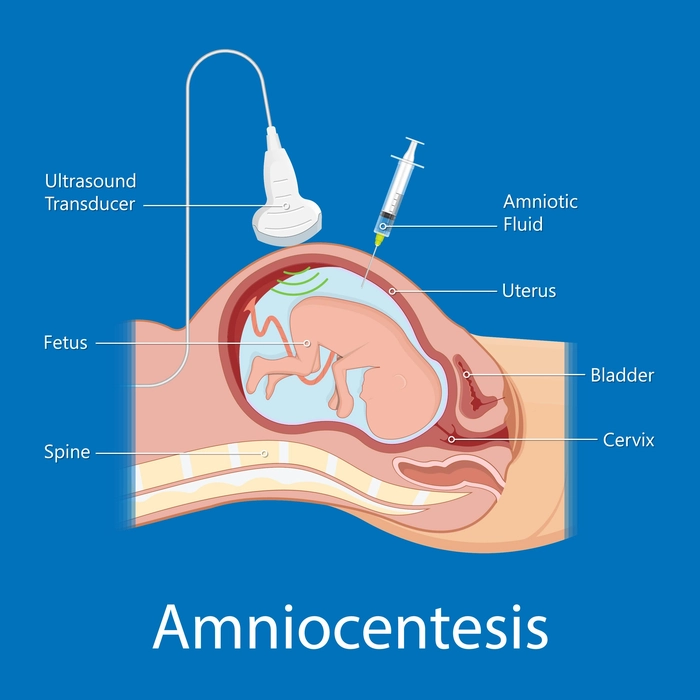Introduction
The word ‘amnio’ (Greek in origin) means inner membrane around the foetus and ‘centesis’ means to prick i.e. amniocentesis refers to the procedure of obtaining amniotic fluid by making a tiny puncture in the inner membrane surrounding the foetus. It is a prenatal test which is carried out before or during pregnancy. Amniocentesis is a procedure used to detect particular genetic disorders which may be due to some chromosomal abnormalities or aberrations. Genetic disorders such as colour blindness, haemophilia, Turner’s syndrome, Down syndrome, etc can be detected through this process. It is often carried out after 15 weeks of pregnancy, or after the first trimester (3 months). If an abnormality is found during this process, then depending upon the health of the baby the decision will be taken whether to continue the pregnancy or not.
Procedure of Amniocentesis
Amniocentesis is performed by a team of professionals. A small amount of amniotic fluid is removed from the abdomen using a needle and is submitted to a lab for analysis. Amniocentesis is an intrusive process that involves inserting a needle into the uterus.
The procedure of amniocentesis is as follows-
- Ultrasound-To determines the position of the placenta, the foetus’ movements, and the features of the amniotic fluid an Ultrasound is conducted. An ultrasound helps to decide which needle to use, the area where the needle will be inserted and the angle at which the needle can be administered.
- Sterilisation-To reduce the danger of infection, the abdomen is first sterilised with an antiseptic, and tools with heparin coatings are used to prevent blood clotting.
- Needle insertion-Depending on the doctor’s preference, either a single-needle or two-needle approach is employed for the needle insertion. To ensure that a good quality sample is extracted the needle is injected in a specific location, and 20 ml of amniotic fluid is extracted.
- This fluid collected is sent to the laboratory for analysis of any genetic disorders.

Reasons for performing Amniocentesis
Some of the common reasons to perform amniocentesis are as follows-
- The main purpose of amniocentesis is to find genetic disorders such as Down syndrome, Turner’s syndrome etc.
- Additionally, neural tube abnormalities, in which the brain and spinal cord are still immature, can also be found through this process.
- It is used to determine whether the lungs of the developing foetus are mature enough for the foetus to take birth.
- When a mother’s blood has an Rh infection i.e. the mother’s blood produces antibodies against foetal blood the baby may develop anaemia. This can be detected by amniocentesis and can be cured.
- Sometimes excessive amniotic fluid gets accumulated in the body, then this process can detect it and excessive amniotic fluid can be removed.
- DNA from the collected amniotic fluid is used in paternity tests to determine blood relations.
Summary
Genetic disorders in the growing foetus are identified using a procedure called amniocentesis. The defects in chromosomes created during cell division are the root cause of genetic diseases. Amniotic fluid, which contains foetal cells, surrounds the foetus. This fluid is sampled in small amounts to perform the examination and look for any abnormalities in the foetus. If there are any abnormalities then depending on the condition of the baby and its health the decision of aborting the child or keeping the child is taken.
Frequently Asked Questions
1. What are the various risks involved in the process of amniocentesis
Ans: There are various risks associated with the process of amniocentesis such as-
- Amniocentesis can cause miscarriages as a small cut is made to extract the amniotic fluid.
- This procedure can cause cramping in the mother as she has to stay still during the entire process.
- There is a high chance that this process can cause injuries to the foetus.
- If the process is not done correctly then it might cause leaking of the amniotic fluid through the point of puncture.
- If by chance this process is done in the second trimester of the pregnancy then there are chances of preterm labour.
2. What precautions should be taken post performing amniocentesis
Ans: Following precautions should be taken post-amniocentesis-
- Normal activities can be resumed after the amniocentesis operation, however rigorous activities should be avoided for up to 24 hours.
- If post operation she suffers vaginal bleeding or a significant loss of amniotic fluid, she must immediately see a doctor.
- If the mother has a fever, severe uterine cramps for more than a few hours, and no abnormal foetal activity and redness or inflammation where the injection was made, then she should immediately see the doctor.
3. What happens if a test for Down syndrome is positive?
Ans: If the test results are positive you will be offered a diagnostic test, typically a chorionic villus sample (CVS) or maybe an amniocentesis, Whether or not the pregnancy is truly impacted will be depended on the test that is performed. CVS is usually done between 10 and 13 weeks of pregnancy.